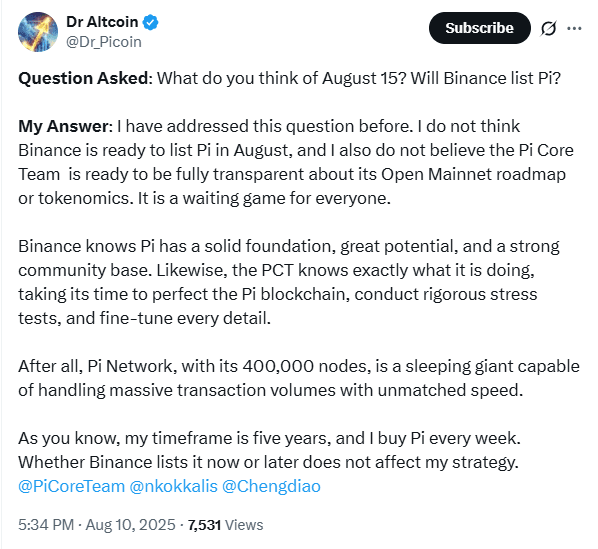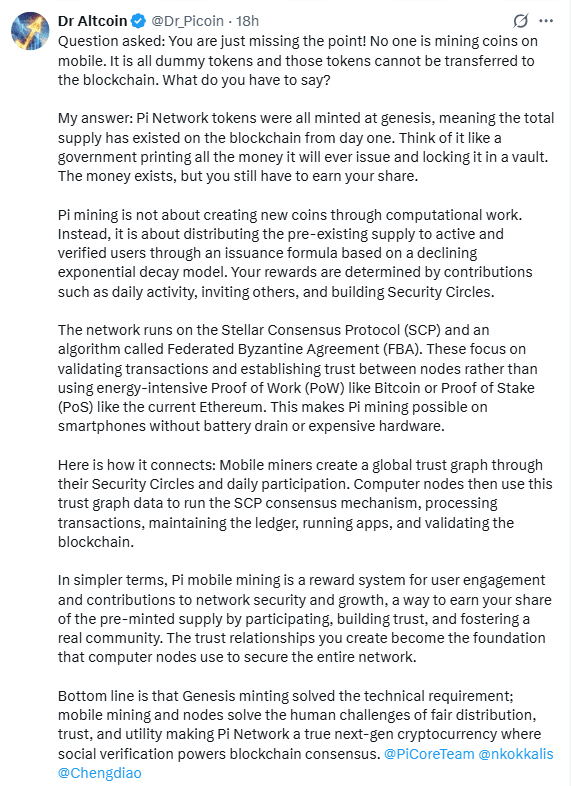Dr. Altcoin stated that Binance does not plan to list Pi Network in August 2025, raising an ongoing debate within the ecosystem.
He explains that both the exchange and the Pi Core Team still have a lot of work to do before such a move can take place.
He pointed out that the ongoing technical steps and the regulatory preparations are the reasons for the delays.
The analyst stated that the listing on Binance in August is impossible for Pi Coin.
Renowned cryptocurrency analyst Dr. Altcoin stated that he does not believe Binance will list Pi Network this month.
He answered questions from the community and stated that both Binance and the Pi Core Team are not yet ready.
He mentioned that the Pi Core Team has not fully disclosed details about the Open Mainnet plan or tokenomics. This, he said, makes a listing this month unlikely.
According to him, Binance understands that Pi has a large community and a solid technical foundation, but both sides are still in the preparation process.
Dr. Altcoin describes Pi Network as a network with over 400,000 active nodes and the ability to handle large transaction volumes at high speeds.

He mentioned that his views on Pi are based on a 5-year plan and he continues to buy this coin weekly.
He noted that whether Binance lists this coin now or later does not affect his approach.
Pi Network's KYC system is designed for global scale.
In a separate tweet, Dr. Altcoin discussed the identity verification process of Pi Network.
He mentioned that with millions of users in over 230 countries and regions, no external provider can meet the network's needs.
Pi Network has created its own KYC system to address this issue. The system uses automated checks and input data from a global user base to review documentation.
This helps verify various types of identities while still meeting compliance rules.
He stated that this process is designed to handle the scale of the network and could serve as a model for other processes.
He added that some people still call Pi a scam, but he pointed out that the project has built this system to meet both technical and regulatory needs.
How mining and providing Pi works.
Some critics argue that Pi's mobile mining activity is creating non-existent or non-transferable coins.
Dr. Altcoin explains that all Pi coins were created when the network started. He compares this to printing all the money at once and holding onto it until it is earned.
Mining on Pi does not create new coins. Instead, it shares a portion of the existing supply with users based on activity, inviting others to join, and security circles.
The supply will be released over time using a formula that reduces rewards as more participants join.
Pi Network operates based on the Stellar Consensus Protocol and the Byzantine Federated Agreement.

These systems focus on building trust among nodes and validating transactions without using as much energy as Proof of Work.
Mobile miners help create a reliable network, and the computer nodes use it to validate transactions and maintain the operation of the blockchain.
Dr. Altcoin stated that this design was created to distribute money fairly and build trust, while allowing the network to be operated from mobile devices and ordinary computers.
The role of Pi Coin in the cryptocurrency market is changing.
Dr. Altcoin stated that many cryptocurrencies are facing challenges regarding infrastructure, accessibility, and regulation.
He noted that the U.S. has enacted the GENIUS Act for stablecoins, showing how regulations around digital assets are evolving.
According to his works, he compared this with Pi Network's focus on regulation, broad accessibility through mobile mining, and low environmental impact.
He also mentioned that Samson Mow has claimed that Ethereum investors move between Bitcoin and ETH to influence prices.
For him, Pi's partnership with service providers like TransFi and Banxa could mitigate the impact of such market fluctuations.
He added that building a peer-to-peer system and avoiding the use of multiple centralized exchanges could help limit manipulation, and Pi Network is aiming for that goal.

